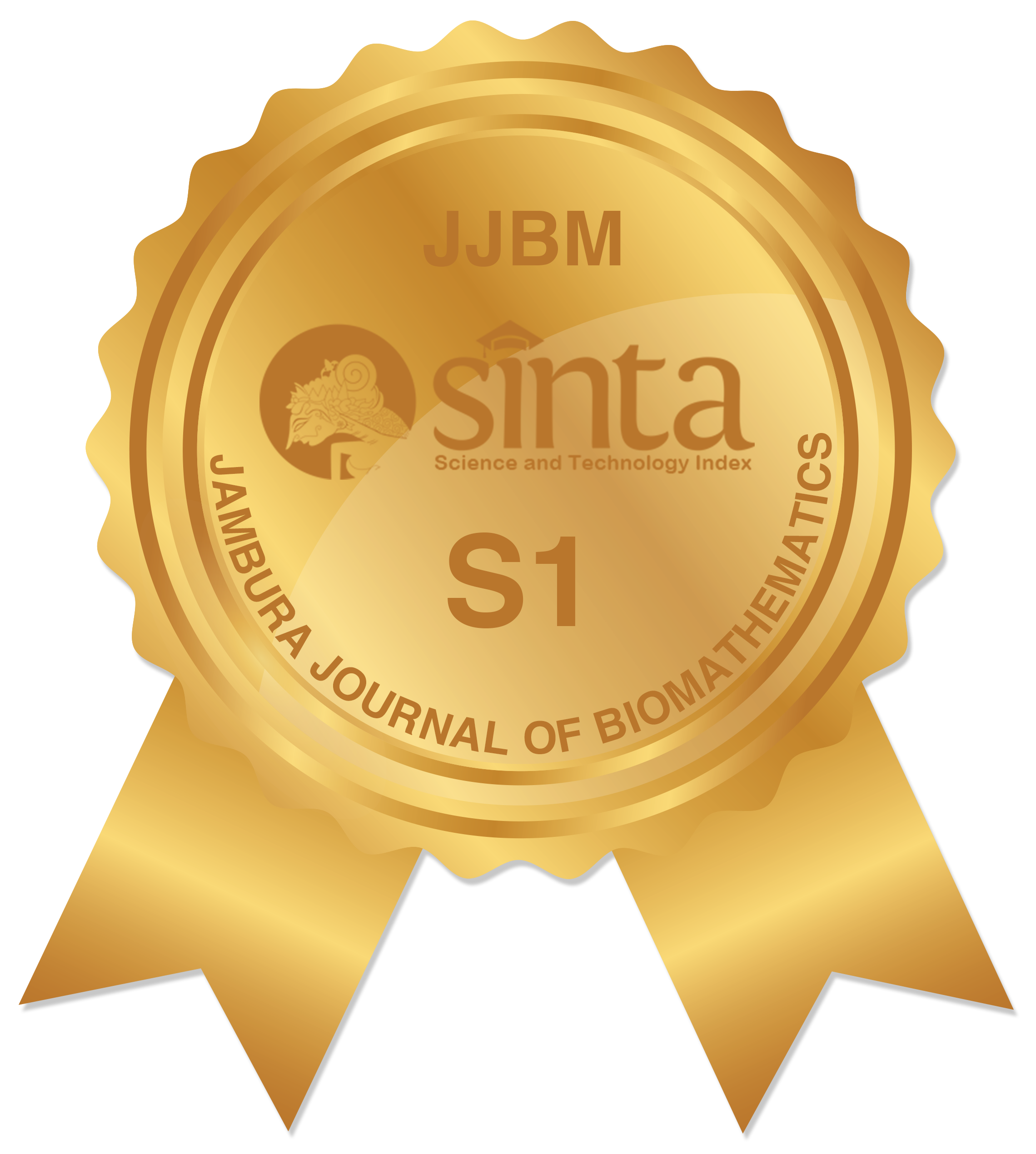A Non-linear Fractional Model for Analyzing the Impact of Vaccination on the Dynamics of COVID-19 in Indonesia
Abstract
Keywords
Full Text:
PDFReferences
NHS. England, “Landmark moment as first nhs patient receives covid-19 vaccination,”2020, https://www.england.nhs.uk/2020/12/landmark-moment-as-first-nhs-patient-receives-covid-19-vaccination/, Accesed on 30 January 2025.
E. Mathieu et al., “Coronavirus pandemic (covid-19). our world in data,” 2024, https://ourworldindata.org/coronavirus, Accesed on 30 January 2025.
N. Imai et al., “Interpreting estimates of coronavirus disease 2019 (covid-19) vaccine efficacy and effectiveness to inform simulation studies of vaccine impact: a systematic review,” Wellcome Open Res., vol. 6, p. 185, 2021. DOI:10.12688/wellcomeopenres.16992.1
O. J. Wouters et al., “Challenges in ensuring global access to covid-19 vaccines: production, affordability, allocation, and deployment,” The Lancet, vol. 397, no. 10278, pp. 1023–1034, 2021. DOI:10.1016/S0140-6736(21)00306-8
H. Wang et al., “Estimating excess mortality due to the covid-19 pandemic: a systematic analysis of covid-19-related mortality, 2020–21,” The Lancet, vol. 399, no. 10334, pp. 1513–1536, 2022. DOI:10.1016/S0140-6736(21)02796-3
A. B. Hogan et al., “Within-country age-based prioritisation, global allocation, and public health impact of a vaccine against sars-cov-2: a mathematical modelling analysis,” Vaccine, vol. 39, no. 22, pp. 2995–3006, 2021. DOI:10.1016/j.vaccine.2021.04.002
W. H. Organization, “Fair allocation mechanism for covid-19 vaccines through the covax facility,” 2020, https://www.who.int/publications/m/item/fair-allocation-mechanism-for-covid-19-vaccines-through-the-covax-facility, Accesed on 30 January 2025.
E. S. K. Besson et al., “Excess mortality during the covid-19 pandemic: a geospatial and statistical analysis in aden governorate, yemen,” BMJ Glob Health, vol. 6, no. 3, p. e004564, 2021. DOI:10.1136/bmjgh-2020-004564
W. H. Organization, “Achieving 70% covid-19 immunization coverage by mid-2022,” 2021, https://www.who.int/news/item/23-12-2021-achieving-70-covid-19-immunization-coverage-by-mid-2022, Accesed on 30 January 2025.
S. Machingaidze and C. S. Wiysonge , “Understanding covid-19 vaccine hesitancy,” Nat. Med., vol. 27, no. 8, pp. 1338–1339, 2021. DOI:10.1038/s41591-021-01459-7
D. Bernoulli, “Essai d’une nouvelle analyse de la mortalité causée par la petite vérole. mém,” Math Phys Acad Roy Sci Paris, vol. 1, pp. 1–45, 1766.
W. O. Kermack and A. G. McKendrick, “A contribution to the mathematical theory of epidemics,” Proc. R. Soc. Lond., vol. 115, no. 772, pp. 700–721, 1927
F. Kemp et al., “Modelling covid-19 dynamics and potential for herd immunity by vaccination in austria, luxembourg and sweden,” J. Theor. Biol., vol. 530, p. 110874, 2021. DOI:10.1016/j.jtbi.2021.110874
C. Treesatayapun, “Model dynamics and optimal control for intervention policy of covid-19 epidemic with quarantine and immigrating disturbances,” Bull Math Biol., vol. 84, no. 11, p. 122, 2022. DOI10.1007/s11538-022-01080-w
M. Rafiq et al., “Numerical analysis of a bi-modal covid-19 sitr model,” Alex Eng J., vol. 61, no. 1, pp. 227–235, 2022. DOI:10.1016/j.aej.2021.04.102
E. Acheampong et al., “Mathematical modelling of earlier stages of covid-19 transmission dynamics in ghana,” Results Phys., vol. 34, p. 105193, 2022. DOI:10.1016/j.rinp.2022.105193
Y. Liu, J. W. Tang, and T. T. Y. Lam, “Transmission dynamics of the covid-19 epidemic in england,” Int. J. Infect Dis., vol. 104, pp. 132–138, 2021. Doi:10.1016/j.ijid.2020.12.055
S. M. Kassa, J. B. H. Njagarah, and Y. A. Terefe, “Analysis of the mitigation strategies for covid-19: from mathematical modelling perspective.” Chaos Solitons Fractals, vol. 138, p. 109968, 2020. DOI: 10.1016/j.chaos.2020.109968
K. S. Sharov , “Creating and applying sir modified compartmental model for calculation of covid-19 lockdown efficiency,” Chaos Solitons Fractals, vol. 141, p. 110295, 2020. DOI:10.1016/j.chaos.2020.110295
Z. W. Tong et al., “Global transmission dynamic of sir model in the time of sars-cov-2,” Results Phys., vol. 25, p. 104253, 2021. DOI:10.1016/j.rinp.2021.104253
Pai C, Bhaskar A, Rawoot V, “Investigating the dynamics of covid-19 pandemic in india under lockdown,” Chaos Solitons Fractals, vol. 138, p. 109988, 2020. DOI:10.1016/j.chaos.2020.109988
B. Huang et al., “Integrated vaccination and physical distancing interventions to prevent future covid-19 waves in chinese cities,” Nat Hum Behav., vol. 5, no. 6, pp. 695–705, 2021. DOI:10.1038/s41562-021-01063-2
P. Sah et al., “Accelerated vaccine rollout is imperative to mitigate highly transmissible covid-19 variants,” EClinicalMedicine, vol. 35, p. 100865, 2021. DOI:10.1016/j.eclinm.2021.100865
M. A. Kuddus, M. Mohiuddin, and A. Rahman, “Mathematical analysis of a measles transmission dynamics model in bangladesh with double dose vaccination,” Sci. Rep., vol. 11, no. 1, p. 16571, 2021. DOI:10.1038/s41598-021-95913-8
M. De la Sen et al., “On a discrete seir epidemic model with two-doses delayed feedback vaccination control on the susceptible,” Vaccines, vol. 9, no. 4, p. 398, 2021. DOI:10.3390/vaccines9040398
M. G. Gomes et al., “Individual variation in susceptibility or exposure to sars-cov-2 lowers the herd immunity threshold,” J. Theor. Biol., vol. 540, p. 111063, 2022. DOI:10.1016/j.jtbi.2022.111063
S. Moore et al., “Vaccination and non-pharmaceutical interventions for covid-19: a mathematical modelling study,” Lancet Infect. Dis., vol. 21, no. 6, pp. 793–802, 2021. DOI:10.1016/S1473-3099(21)00143-2
P. Yang et al., “The effect of multiple interventions to balance healthcare demand for controlling covid-19 outbreaks: a modelling study,” Sci Rep., vol. 11, no. 1, p. 3110, 2021. DOI:10.1038/s41598-021-82170-y
D. Martínez-Rodríguez, G. Gonzalez-Parra, and R. Villanueva, “Analysis of key factors of a sars-cov-2 vaccination program: A mathematical modeling approach,” Epidemiologia., vol. 2, no. 2, pp. 140–161, 2021. DOI:10.3390/epidemiologia2020012
A. Fuady et al., “Targeted vaccine allocation could increase the covid-19 vaccine benefits amidst its lack of availability: A mathematical modeling study in indonesia,” Vaccines, vol. 9, no. 5, p. 462, 2021. DOI:10.3390/vaccines9050462
A. M. Ramos et al., “Modeling the impact of sars-cov-2 variants and vaccines on the spread of covid-19,” Commun Nonlinear Sci Numer Simul., vol. 102, p. 105937, 2021. DOI:DOI:10.1016/j.cnsns.2021.105937
E. F. Arruda et al., “Modelling and optimal control of multi strain epidemics, with application to covid-19,” PLoS ONE, vol. 16, no. 9, p. e0257512, 2021. DOI:10.1371/journal.pone.0257512
U. A. de León, E. Avila-Vales, and K. Huang, “Modeling covid-19 dynamic using a two-strain model with vaccination,” Chaos Solitons Fractals, vol. 157, p. 111927, 2022. DOI:10.1016/j.chaos.2022.111927
A. Abidemi, Z. M. Zainuddin, and N. A. B. Aziz, “Impact of control interventions on COVID-19 population dynamics in Malaysia: a mathematical study,” The European Physical Journal Plus, vol. 136, no. 2, p. 237, 2021. DOI:10.1140/epjp/s13360-021-01205-5
F. Nyabadza et al., “Modelling the potential impact of social distancing on the covid-19 epidemic in south africa,” Computational and mathematical methods in medicine, vol. 2020, no. 1, p. 5379278, 2020. DOI:10.1155/2020/5379278
M. A. Rois, Fatmawati, and C. Alfiniyah, “Two isolation treatments on the covid-19 model and optimal control with public education,” Jambura Journal of Biomathematics (JJBM), vol. 4, no. 1, pp. 88–94, 2023. DOI:10.34312/jjbm.v4i1.19963
J. O. Akanni, Fatmawati, and C. W. Chukwu, “On the fractional-order modeling of covid-19 dynamics in a population with limited resources,” Communi. in Math. Bio. and Neurosci., vol. 2023, pp. 1–36, 2023. DOI:10.28919/cmbn/7875
S. Olaniyi et al., “Mathematical modelling and optimal cost-effective control of covid-19 transmission dynamics,” Eur. Phys. J., vol. 135(11):, pp. 1–20, 2020. DOI:10.1140/epjp/s13360-020-00954-z
C. J. Edholm et al., “A vaccination model for covid-19 in gauteng, south africa,” Infectious Disease Modelling, vol. 7, no. 3, pp. 333–345, 2022. DOI:10.1016/j.idm.2022.06.002
R. Syafitri, Trisilowati, and W. M. Kusumawinahyu, “Dynamics of covid-19 model with public awareness, quarantine, and isolation,” Jambura Journal of Biomathematics (JJBM), vol. 4, no. 1, pp. 63–68, 2023. DOI:10.34312/jjbm.v4i1.19832
M. S. Islam et al., “Covid-19 epidemic compartments model and bangladesh,” Preprints, 2020. DOI:10.20944/preprints202004.0193.v1
R. M. Yaseen et al., “The modeling and mathematical analysis of the fractional-order of cholera disease: Dynamical and simulation,” Partial Differential Equations in Applied Mathematics, vol. 12, p. 100978, 2024. DOI:10.1016/j.padiff.2024.100978
R. M. Yaseen et al., “Improving the hepatitis viral transmission model’s dynamics by vaccination and contrasting it with the fractional-order model,” Partial Differential Equations in Applied Mathematics, vol. 10, p. 100705, 2024. DOI:10.1016/j.padiff.2024.100705
A. A. Mohsen, H. F. AL-Husseiny, and R. K. Naji, “The dynamics of coronavirus pandemic disease model in the existence of a curfew strategy,” Journal of Interdisciplinary Mathematics, vol. 25, no. 6, pp. 1777–1797, 2022. DOI:10.1080/09720502.2021.2001139
A. Ali and R. K. Naji, “Dynamical analysis within-host and between-host for hiv/aids with the application of optimal control strategy,” Iraqi Journal of Science, vol. 61, no. 5, pp. 1173–1189, 2020. DOI:10.24996/ijs.2020.61.5.25
A. M. Niger and A. B. Gumel, “Mathematical analysis of the role of repeated exposure on malaria transmission dyanmivs,” Differ. Equ. Dyn. Syst., vol. 16, no. 3, pp. 251–287, 2008. DOI:10.1007/s12591-008-0015-1
S. Olaniyi, “Dynamics of zika virus model with nonlinear incidence and optimal control strategies,” Appl. Math. Inf. Sci., vol. 12, no. 5, pp. 969–982, 2018. DOI:10.18576/amis/120510
J. O. Akanni, “Asymptotic stability of illicit drug dynamics with banditry compartment,” Appl. Math. Inf. Sci., vol. 14, no. 5, pp. 791–800, 2020. DOI:10.18576/amis/140506
H. W. Hethcote, “The mathematics of infectious disease,” SIAM Review, vol. 42, no. 4, pp. 599–653, 2000. DOI:10.1137/S0036144500371907
P. Van den Driessche and J. Watmough, “Reproduction numbers and sub-threshold endemic equilibria for compartmental models of disease transmission,” Mathematical Biosciences, vol. 180, no. 1–2, pp. 29–48, 2002. DOI:10.1016/S0025-5564(02)00108-6
A. Abidemi and N. A. B. Aziz , “Analysis of deterministic models for dengue disease transmission dynamics with vaccination perspective in Johor, Malaysia,” International Journal of Applied and Computational Mathematics, vol. 8, no. 1, p. 45, 2022. DOI:10.1007/s40819-022-01250-3
A. Abidemi, J. O. Akanni, and O. D. Makinde, “A non-linear mathematical model for analysing the impact of COVID-19 disease on higher education in developing countries,” Healthcare Analytics, vol. 3, p. 100193, 2023. DOI:10.1016/j.health.2023.100193
O. W. in Data, “Data on COVID-19 (coronavirus),” 2024, https://github.com/owid/covid-19-data/tree/master/public/data, Accessed 30 January 2025.
J. O. Akanni, “A non-linear optimal control model for illicit drug use and terrorism dynamics in developing countries with time-dependent control variables,” Decision Analytics Journal, vol. 8, p. 100281, 2023. DOI:10.1016/j.dajour.2023.100281
D. Okuonghae and A. Omame, “Analysis of a mathematical model for COVID-19 population dynamics in Lagos, Nigeria,” Chaos, Solitons and Fractals, vol. 139, p. 110032, 2020. DOI:10.1016/j.chaos.2020.110032
I. Podlubny, “Fractional differential equations.” San Diego: Academic Press, 1998.
Z. M. Odibat and N. T. Shawagfeh, “Generalized taylor’s formula,” Applied Mathematics Computation, vol. 186, no. 1, pp. 286–293, 2007. DOI:10.1016/j.amc.2006.07.102
S. Mangal, O. Misra, and J. Dhar, “Fractional-order deterministic epidemic model for the spread and control of hiv/aids with special reference to mexico and india,” Mathematics Computation Simulation, vol. 210, pp. 82–102, 2023. DOI:10.1016/j.matcom.2023.03.008
J. K. K. Asamoah et al., “Global stability and cost-effectiveness analysis of covid-19 considering the impact of the environment: using data from Ghana,” Chaos, Solitons & Fractals, vol. 140, p. 110103, 2020. DOI:10.1016/j.chaos.2020.110103
S. Olaniyi and O. S. Obabiyi, “Qualitative analysis of malaria dynamics with nonlinear incidence function,” Applied Mathematical Sciences, vol. 8, no. 78, pp. 3889–3904, 2014. DOI:10.12988/ams.2014.45326
DOI: https://doi.org/10.37905/jjbm.v6i2.30383
Copyright (c) 2025 John Olajide Akanni, Afeeze Abidemi, Fatmawati Fatmawati, Chidozie Williams Chukwu

This work is licensed under a Creative Commons Attribution-NonCommercial 4.0 International License.
Jambura Journal of Biomathematics (JJBM) has been indexed by:
EDITORIAL OFFICE OF JAMBURA JOURNAL OF BIOMATHEMATICS |
 | Department of Mathematics, Faculty of Mathematics and Natural Science, Universitas Negeri Gorontalo Jl. Prof. Dr. Ing. B. J. Habibie, Moutong, Tilongkabila, Kabupaten Bone Bolango 96554, Gorontalo, Indonesia |
 | Email: [email protected] |
 | +6281356190818 (WA Only) |
 | Jambura Journal of Biomathematics (JJBM) by Department of Mathematics Universitas Negeri Gorontalo is licensed under a Creative Commons Attribution-NonCommercial 4.0 International License. Powered by Public Knowledge Project OJS. |
















